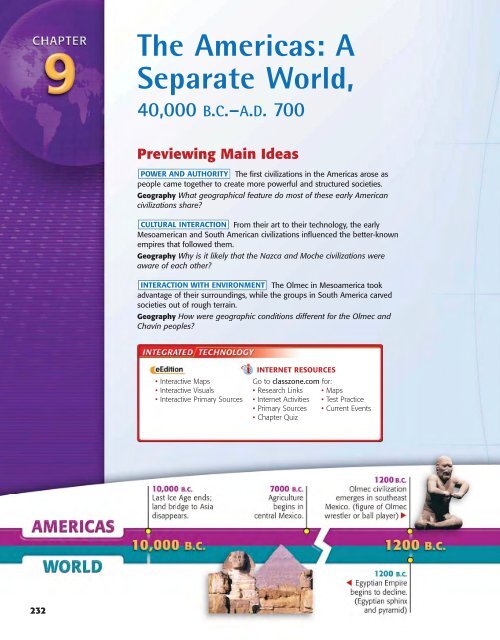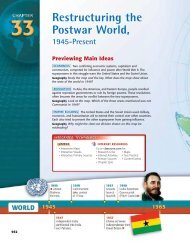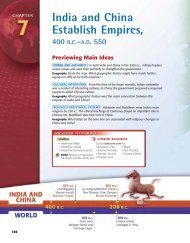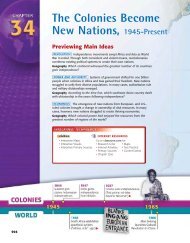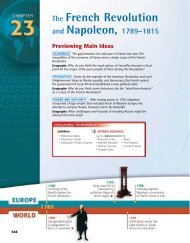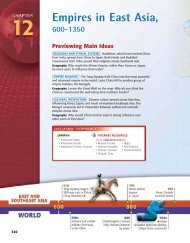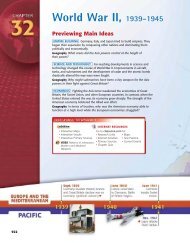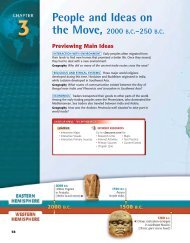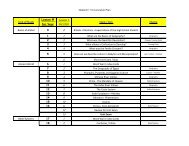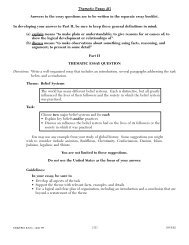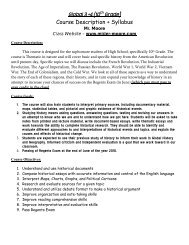The Americas: A Separate World, - First
The Americas: A Separate World, - First
The Americas: A Separate World, - First
Create successful ePaper yourself
Turn your PDF publications into a flip-book with our unique Google optimized e-Paper software.
232<br />
<strong>The</strong> <strong>Americas</strong>: A<br />
<strong>Separate</strong> <strong>World</strong>,<br />
40,000 B.C.–A.D. 700<br />
Previewing Main Ideas<br />
POWER AND AUTHORITY <strong>The</strong> first civilizations in the <strong>Americas</strong> arose as<br />
people came together to create more powerful and structured societies.<br />
Geography What geographical feature do most of these early American<br />
civilizations share?<br />
CULTURAL INTERACTION From their art to their technology, the early<br />
Mesoamerican and South American civilizations influenced the better-known<br />
empires that followed them.<br />
Geography Why is it likely that the Nazca and Moche civilizations were<br />
aware of each other?<br />
INTERACTION WITH ENVIRONMENT <strong>The</strong> Olmec in Mesoamerica took<br />
advantage of their surroundings, while the groups in South America carved<br />
societies out of rough terrain.<br />
Geography How were geographic conditions different for the Olmec and<br />
Chavín peoples?<br />
• Interactive Maps<br />
• Interactive Visuals<br />
• Interactive Primary Sources<br />
INTERNET RESOURCES<br />
Go to classzone.com for:<br />
• Research Links • Maps<br />
• Internet Activities • Test Practice<br />
• Primary Sources • Current Events<br />
• Chapter Quiz
233
How can killing a mammoth<br />
help you survive?<br />
You are a hunter living in ancient North America. Along with several other<br />
hunters, you have been tracking the mammoth for days. This giant beast is a<br />
challenging prey. Close to 14 feet high at the shoulders, it can easily crush a<br />
human. Its curved tusks, measuring more than 15 feet in length, are sharp and<br />
therefore dangerous. Yet the rewards of killing the huge animal are worth the<br />
risks for you, your fellow hunters, and your families.<br />
Suddenly you spot the massive creature. Aside from spears, your only<br />
weapons are some simple tools and your superior intelligence.<br />
Should a hunter get too<br />
close, the mammoth might<br />
crush him under its large<br />
feet, or stab him with its<br />
deadly tusks.<br />
• What uses might hunters and their families make of<br />
the slain mammoth?<br />
• What roles might strategy and cooperation play in<br />
the hunt?<br />
As a class, discuss these questions. In your discussion, consider how<br />
this situation speaks to the difficulties of life in a hunter-gatherer<br />
society. As you read about the growth of civilization in the<br />
<strong>Americas</strong>, notice how the old hunting and gathering way of life<br />
dramatically changed with the development of agriculture.<br />
234<br />
EXAMINING the ISSUES<br />
Other hunters close<br />
in for the kill.<br />
<strong>The</strong> hunter uses a spearthrowing<br />
device to steady<br />
the spear and extend the<br />
length it travels. <strong>The</strong> device<br />
gives the hunter greater<br />
force and accuracy in hurling<br />
his spear from a distance.
MAIN IDEA WHY IT MATTERS NOW TERMS & NAMES<br />
POWER AND AUTHORITY <strong>The</strong><br />
cultures of the first Americans,<br />
including social organization,<br />
developed in ways similar to<br />
other early cultures.<br />
1<br />
<strong>The</strong> Earliest Americans<br />
<strong>The</strong> <strong>Americas</strong>’ first inhabitants<br />
developed the basis for later<br />
American civilizations.<br />
• Beringia<br />
• Ice Age<br />
SETTING THE STAGE While civilizations were developing in Africa, Asia,<br />
and Europe, they were also emerging in the <strong>Americas</strong>. Human settlement in the<br />
<strong>Americas</strong> is relatively recent compared to that in other parts of the world.<br />
However, it followed a similar pattern. At first the ancient people of the <strong>Americas</strong><br />
survived mainly by hunting. Over time, they developed farming methods that<br />
ensured a more reliable supply of food. This in turn led to the growth of the first<br />
civilizations in the <strong>Americas</strong>.<br />
A Land Bridge<br />
<strong>The</strong> American continents include North and South America. <strong>The</strong>y are connected<br />
and span two hemispheres, from the frigid Arctic Circle in the north to the icy<br />
waters around Antarctica in the south. Although this land mass narrows greatly<br />
around modern-day Panama, it stretches unbroken for about 9,000 miles. This<br />
large and rugged land is isolated from the rest of the world by vast oceans. Yet,<br />
thousands of years ago, the <strong>Americas</strong> were connected by a land bridge to Asia.<br />
Most experts believe that some of the first people came to the <strong>Americas</strong> from<br />
Asia over this land bridge. <strong>The</strong> land bridge is known as Beringia. Other people<br />
may have arrived by boat.<br />
Peopling the <strong>Americas</strong> <strong>The</strong> first Americans arrived sometime toward the end<br />
of the last Ice Age, which lasted from roughly 1.9 million to about 10,000 B.C.<br />
Huge sheets of moving ice, called glaciers, spread southward from the Arctic<br />
Circle. <strong>The</strong>y covered large portions of North America. <strong>The</strong> buildup of glaciers<br />
locked up huge amounts of the earth’s water. It lowered sea levels and created a<br />
land corridor between Asia and Alaska across what is now the Bering Strait.<br />
Herds of wild animals from Siberia, including the mammoth, migrated across<br />
the plains of the Beringia land bridge. Gradually, Siberian hunters followed these<br />
animals into North America. <strong>The</strong>y most likely were unaware that they were entering<br />
a new continent. <strong>The</strong>se migrants became the first Americans.<br />
Thomas Canby, a writer for National Geographic magazine, spent a year with<br />
archaeologists as they searched for ancient burial sites throughout the <strong>Americas</strong>.<br />
From his experience, Canby described the type of world that might have greeted<br />
these hunters and migrants as they entered the <strong>Americas</strong>:<br />
• maize<br />
TAKING NOTES<br />
Analyzing Causes and<br />
Recognizing Effects<br />
Use a chart to list<br />
causes and effects of<br />
the development of<br />
the <strong>Americas</strong>.<br />
Cause<br />
1.<br />
2.<br />
Effect<br />
1.<br />
<strong>The</strong> <strong>Americas</strong>: A <strong>Separate</strong> <strong>World</strong> 235<br />
2.
236 Chapter 9<br />
PRIMARY SOURCE<br />
What a wild world it was! To see it properly, we must board a time machine and<br />
travel back into the Ice Age. <strong>The</strong> northern half of North America has vanished,<br />
buried beneath ice sheets two miles thick. Stretching south to Kentucky, they<br />
buckle the earth’s crust with their weight. . . . Animals grow oversize. . . . Elephanteating<br />
jaguars stand tall as lions, beavers grow as big as bears, South American<br />
sloths as tall as giraffes. With arctic cold pushing so far southward, walrus bask on<br />
Virginia beaches, and musk-oxen graze from Maryland to California.<br />
THOMAS CANBY, “<strong>The</strong> Search for the <strong>First</strong> Americans,” National Geographic<br />
No one knows for sure when the first Americans arrived. Some scholars contend<br />
that the migration across the land bridge began as early as 40,000 B.C. Others argue<br />
it occurred as late as 10,000 B.C. For years, many researchers have regarded the discovery<br />
of spearheads dating back to 9500 B.C. near Clovis, New Mexico, to be the<br />
earliest evidence of humankind in the <strong>Americas</strong>.<br />
However, recent discoveries of possible pre-Clovis sites have challenged this<br />
theory. One such discovery was made at Monte Verde, Chile, near the southern tip<br />
of the <strong>Americas</strong>. Researchers there have found evidence of human life dating back<br />
to 10,500 B.C. Underneath this site—a sandy bank near a creek—archaeologists<br />
discovered pieces of animal hide and various tools. <strong>The</strong>y also found a preserved<br />
chunk of meat and a child’s single footprint. <strong>The</strong> evidence at Monte Verde suggests<br />
that the first Americans arrived well before the Clovis era. To reach southern Chile<br />
at such an early date, some experts believe, humans would have had to cross the<br />
land bridge at least 20,000 years ago.<br />
Most experts believe the earliest Americans traveled by foot across the land<br />
bridge. However, some scholars think they also may have paddled from Asia to the<br />
Pacific Coast in small boats. A skull discovered near Mexico City has recently<br />
been dated to about 11,000 B.C., making it the oldest skull ever found in the<br />
<strong>Americas</strong>. Some scientists studying the skull believe that it is related to the Ainu<br />
people of Japan and that these descendants of the Ainu reached the <strong>Americas</strong> by<br />
island-hopping on boats.<br />
Hunters and Gatherers<br />
Questions remain about how and when the first Americans arrived. What appears<br />
more certain—from the discovery of chiseled spearheads and charred bones at<br />
ancient sites—is that the earliest Americans lived as hunters. Perhaps their most<br />
challenging and rewarding prey was the mammoth. Weighing more than seven tons,<br />
this animal provided meat, hide, and bones for food, clothing, shelters, and tools.<br />
Following the Game Eventually, large animals like the mammoth were overhunted<br />
and became extinct. Hunters soon turned to smaller prey, such as deer and<br />
rabbits, for their survival. <strong>The</strong>y also fished and gathered edible plants and fruits.<br />
Because they were hunters, the earliest Americans found it necessary to move regularly<br />
in search of food. Whenever they did settle in one place for a short time, prehistoric<br />
Americans lived in caves or temporary shelters in the open air.<br />
With the end of the Ice Age, around 12,000 to 10,000 years ago, came the end<br />
of land travel across Beringia. As the great glaciers melted, sea levels rose. <strong>The</strong><br />
ancient land bridge disappeared under the Bering Strait. By this time, however,<br />
humans inhabited most regions of the <strong>Americas</strong>. Wherever they roamed, from the<br />
grassy plains of the modern-day United States to the steamy tropical forests of<br />
Central America, the first Americans adapted to the variety of environments they<br />
inhabited. In doing so, they carved out unique ways of life.<br />
Analyzing<br />
Primary Sources<br />
What might<br />
account for the<br />
abundance of animal<br />
life that Canby<br />
describes?<br />
Recognizing<br />
Effects<br />
How did the<br />
earliest Americans<br />
adapt to the loss of<br />
large animals?
ASIA<br />
160°E<br />
Glacier ice, 12,000 B.C.<br />
Beringia<br />
Possible land migration routes<br />
Possible water migration route<br />
Fossil site<br />
0 2,000 Miles<br />
ARCTIC OCEAN<br />
B e r i n g i a<br />
0 4,000 Kilometers<br />
Migration Routes,<br />
40,000–10,000 B.C.<br />
Spearheads similar to these were first discovered<br />
near Clovis, New Mexico, and later throughout<br />
North America. Many of these artifacts date back to<br />
around 9500 B.C.<br />
160°W<br />
Broken Mammoth, Alaska<br />
11,800 B.C.<br />
40°N<br />
Tropic of Cancer<br />
R O C K Y M O U N T A I N S<br />
120°W<br />
NORTH<br />
AMERICA<br />
PACIFIC<br />
OCEAN<br />
Meadowcroft Rockshelter,<br />
Pennsylvania<br />
17,000 B.C.<br />
Mississippi R.<br />
Clovis, New Mexico<br />
9500 B.C.<br />
0° Equator<br />
80°W<br />
AN D E S MO U N T A I N S<br />
Recent findings at Monte Verde, Chile, have<br />
provided evidence of human life in the <strong>Americas</strong> as<br />
early as 10,500 B.C.<br />
Amazon R.<br />
SOUTH<br />
AMERICA<br />
Monte Verde, Chile<br />
10,500 B.C.<br />
GEOGRAPHY SKILLBUILDER: Interpreting Maps<br />
1. Location What two continents does the Beringia land bridge connect?<br />
2. Movement From where do scholars believe the first Americans came? How did they come?<br />
Travelers across Beringia might have<br />
encountered landscapes such as this in Alaska.<br />
At the Meadowcroft Rockshelter<br />
site in Pennsylvania, pre-Clovis<br />
blades have been found that date<br />
back many thousands of years.<br />
40°W<br />
ATLANTIC<br />
OCEAN<br />
Tropic of Capricorn<br />
40°S<br />
237<br />
0°
A Bison Kill Site<br />
<strong>The</strong> first hunters roaming North<br />
America hunted mammoths, deer,<br />
and bison. Researchers found the<br />
bones of bison at a kill site near<br />
Calgary, Alberta, in Canada. This<br />
kill site is believed to have been<br />
in use for more than 8,000 years.<br />
Different layers of remains and<br />
artifacts have been found at the<br />
kill site, with different kinds of<br />
points—spears, arrows, knives,<br />
and so forth. <strong>The</strong> different styles<br />
of points can tell archaeologists<br />
about the age of a site and its<br />
various layers. Weapons and tools<br />
such as those shown here were<br />
used to kill and butcher animals<br />
for the hunters and their families<br />
to consume.<br />
SKILLBUILDER:<br />
Interpreting Visual Sources<br />
1. Drawing Conclusions What<br />
resources besides food might<br />
animals have provided to early<br />
hunters and their families?<br />
2. Making Inferences What might<br />
have been the effect of the<br />
weapons and tools of early<br />
hunters on the big-game<br />
animals of the <strong>Americas</strong>?<br />
238 Chapter 9<br />
About 4300 B.C.<br />
Mount Mazama<br />
explodes<br />
About A.D. 1<br />
<strong>The</strong> Pelican Lake style points are<br />
the youngest or most recent.<br />
<strong>The</strong>y are about 2,000 years old.<br />
Agriculture Creates a New Way of Life<br />
Gradually, the earliest Americans became more familiar with plant foods. <strong>The</strong>y<br />
began to experiment with simple methods of farming. <strong>The</strong>ir efforts at planting and<br />
harvesting led to agriculture. This dramatically changed their way of life.<br />
<strong>The</strong> Development of Farming Around 7000 B.C., a revolution quietly began in<br />
what is now central Mexico. <strong>The</strong>re, people began to rely more on wild edible<br />
plants, raising some of them from seeds. By 5000 B.C., many had begun to grow<br />
these preferred plants. <strong>The</strong>y included squashes, gourds, beans, avocados, and<br />
chilies. By 3400 B.C., these early farmers grew maize, or corn. Maize soon became<br />
the most important crop. This highly nourishing crop flourished in the tropical climate<br />
of Mexico. <strong>The</strong>re, a family of three could raise enough corn in four months<br />
to feed themselves for a long time.<br />
Gradually, people settled in permanent villages in the Tehuacan (TAY•wuh•KAHN)<br />
Valley, south of present-day Mexico City. <strong>The</strong>se people raised corn and other crops.<br />
<strong>The</strong> techniques of agriculture spread over North and South America. However, it is<br />
believed that people in some areas, such as Peru and eastern North America, may<br />
have discovered the secrets of cultivating local edible plants independently.<br />
About 2500 B.C.<br />
<strong>The</strong> McKean style<br />
points are in the<br />
middle range.<br />
<strong>The</strong>y are about<br />
4,500 years old.<br />
About 6000 B.C.<br />
Other points, buried beneath a layer of volcanic ash,<br />
are the oldest of all. <strong>The</strong>y are about 8,000 years old.<br />
<strong>The</strong> ash arrived in the Calgary area about 6,300 years<br />
ago when Mount Mazama exploded. Deposits beneath<br />
this ash are older than the eruption. <strong>The</strong> bones above<br />
are the remains of a young bison butchered at the site.
Making<br />
Inferences<br />
Why might the<br />
development of<br />
agriculture be characterized<br />
by some<br />
as a turning point<br />
in human history?<br />
Over the next several centuries, farming methods became more advanced. In<br />
central Mexico native farmers created small islands in swamps and shallow lakes<br />
by stacking layers of vegetation, dirt, and mud. <strong>The</strong>y then planted crops on top of<br />
the island soil. <strong>The</strong> surrounding water provided irrigation. <strong>The</strong>se floating gardens<br />
were very productive, yielding up to three harvests a year.<br />
Farming Brings Great Change In the <strong>Americas</strong>, as in other regions of the world,<br />
agriculture brought great and lasting change to people’s way of life. <strong>The</strong> cultivation<br />
of corn and other crops provided a more reliable and expanding food supply. This<br />
encouraged population growth and the establishment of large, settled communities.<br />
As the population grew, and as farming became more efficient and productive,<br />
more people turned their attention to nonagricultural pursuits. <strong>The</strong>y developed specialized<br />
skills in arts and crafts, building trades, and other fields. Differences<br />
between social classes—between rich and poor, ruler and subject—began to<br />
emerge. With the development of agriculture, society became more complex. <strong>The</strong><br />
stage was set for the rise of more advanced civilizations.<br />
SECTION 1 ASSESSMENT<br />
• People hunted or gathered what they<br />
ate.<br />
• Families continually moved in search<br />
of big game.<br />
• Groups remained small due to the<br />
scarcity of reliable sources of food.<br />
• Humans devoted much of their time to<br />
obtaining food.<br />
<strong>The</strong> Effects of Agriculture<br />
Before Agriculture After Agriculture<br />
TERMS & NAMES 1. For each term or name, write a sentence explaining its significance.<br />
• Beringia • Ice Age • maize<br />
USING YOUR NOTES MAIN IDEAS<br />
2. Which effect do you think had 3. How did human beings come<br />
the most significant impact on to the <strong>Americas</strong>?<br />
the <strong>Americas</strong>? Explain. 4. How did humans get food<br />
before the development of<br />
Cause Effect<br />
farming?<br />
1. 1.<br />
5. What sorts of changes did<br />
farming bring?<br />
2. 2.<br />
INTERNET ACTIVITY<br />
Use the Internet to find information on early archaeological sites in<br />
the <strong>Americas</strong>. Locate these sites on an outline map and show the<br />
dates that scientists have assigned to these sites.<br />
• People enjoyed a more reliable and<br />
steady source of food.<br />
• Families settled down and formed<br />
larger communities.<br />
• Humans concentrated on new skills:<br />
arts and crafts, architecture, social<br />
organization.<br />
• Complex societies eventually arose.<br />
SKILLBUILDER: Interpreting Charts<br />
1. Recognizing Effects How did life change after the development of agriculture?<br />
2. Making Inferences How might the establishment of agriculture have helped humans to<br />
develop new skills and interests?<br />
CRITICAL THINKING & WRITING<br />
6. FORMING OPINIONS Why do you think early Americans,<br />
isolated from the rest of the world, developed in ways<br />
similar to other early humans?<br />
7. HYPOTHESIZING What sailing routes might early humans<br />
have traveled to the <strong>Americas</strong>?<br />
8. COMPARING What sorts of problems might the earliest<br />
Americans have encountered in their travels?<br />
9. WRITING ACTIVITY POWER AND AUTHORITY What type of<br />
person might hold power in a hunter-gatherer society? in<br />
a settled, agricultural society? Support your opinions in a<br />
two-paragraph essay.<br />
INTERNET KEYWORD<br />
Clovis, Meadowcroft Rockshelter<br />
<strong>The</strong> <strong>Americas</strong>: A <strong>Separate</strong> <strong>World</strong> 239
240 Chapter 9<br />
MAIN IDEA WHY IT MATTERS NOW TERMS & NAMES<br />
CULTURAL INTERACTION <strong>The</strong><br />
Olmec created the <strong>Americas</strong>’<br />
first civilization, which in turn<br />
influenced later civilizations.<br />
TAKING NOTES<br />
Comparing Use a<br />
Venn diagram to<br />
compare Olmec and<br />
Zapotec cultures.<br />
Olmec<br />
both<br />
Zapotec<br />
Early Mesoamerican Civilizations<br />
2<br />
Later American civilizations<br />
relied on the technology and<br />
achievements of earlier cultures<br />
to make advances.<br />
• Mesoamerica<br />
• Olmec<br />
SETTING THE STAGE <strong>The</strong> story of developed civilizations in the <strong>Americas</strong><br />
begins in a region called Mesoamerica. (See map on opposite page.) This area<br />
stretches south from central Mexico to northern Honduras. It was here, more<br />
than 3,000 years ago, that the first complex societies in the <strong>Americas</strong> arose.<br />
<strong>The</strong> Olmec<br />
Mesoamerica’s first known civilization builders were a people known as the<br />
Olmec. <strong>The</strong>y began carving out a society around 1200 B.C. in the jungles of southern<br />
Mexico. <strong>The</strong> Olmec influenced neighboring groups, as well as the later civilizations<br />
of the region. <strong>The</strong>y often are called Mesoamerica’s “mother culture.”<br />
<strong>The</strong> Rise of Olmec Civilization Around 1860, a worker clearing a field in the<br />
hot coastal plain of southeastern Mexico uncovered an extraordinary stone sculpture.<br />
It stood five feet tall and weighed an estimated eight tons. <strong>The</strong> sculpture<br />
was of an enormous head, wearing a headpiece. (See History Through Art,<br />
pages 244–245.) <strong>The</strong> head was carved in a strikingly realistic style, with thick<br />
lips, a flat nose, and large oval eyes. Archaeologists had never seen anything like<br />
it in the <strong>Americas</strong>.<br />
This head, along with others that were discovered later, was a remnant of the<br />
Olmec civilization. <strong>The</strong> Olmec emerged about 1200 B.C. and thrived from<br />
approximately 800–400 B.C. <strong>The</strong>y lived along the Gulf Coast of Mexico, in the<br />
modern-day Mexican states of Veracruz and Tabasco.<br />
Gulf Coast Geography On the surface, the Gulf Coast seemed an unlikely site<br />
for a high culture to take root. <strong>The</strong> region was hot and humid and covered with<br />
swamps and jungle. In some places, giant trees formed a thick cover that prevented<br />
most sunlight from reaching the ground. Up to 100 inches of rain fell<br />
every year. <strong>The</strong> rainfall swelled rivers and caused severe flooding.<br />
However, the region also had certain advantages. <strong>The</strong>re were abundant<br />
deposits of salt and tar, as well as fine clay used in making pottery. <strong>The</strong>re was<br />
also wood and rubber from the rain forest. <strong>The</strong> hills to the north provided hard<br />
stone from which the Olmec could make tools and monuments. <strong>The</strong> rivers that<br />
laced the region provided a means of transport. Most important, the flood plains<br />
of these rivers provided fertile land for farming.<br />
• Zapotec<br />
• Monte<br />
Albán
Making<br />
Inferences<br />
In what ways<br />
did the Olmec’s<br />
environment help<br />
in the creation of its<br />
civilization?<br />
Hypothesizing<br />
What might<br />
lead to the disappearance<br />
of an<br />
entire civilization?<br />
<strong>The</strong> Olmec used their resources<br />
to build thriving communities. <strong>The</strong><br />
oldest site, San Lorenzo, dates<br />
back to around 1150 B.C. Here<br />
archaeologists uncovered important<br />
clues that offered a glimpse<br />
into the Olmec world.<br />
Olmec Society At San Lorenzo<br />
archaeologists discovered earthen<br />
mounds, courtyards, and pyramids.<br />
Set among these earthworks<br />
were large stone monuments. <strong>The</strong>y<br />
included columns, altars, and<br />
more colossal, sculpted heads,<br />
which may have represented particular<br />
Olmec rulers. <strong>The</strong>se giant<br />
monuments weigh as much as 44<br />
tons. Some scholars think that<br />
Olmec workers may have moved<br />
these sculptures over land on<br />
rolling logs to the river banks.<br />
From there, they may have rafted<br />
the monuments along waterways<br />
to various sites.<br />
To the east of San Lorenzo,<br />
another significant Olmec site, La<br />
Venta, rose around 900 B.C. Here,<br />
researchers discovered a 100-foot-high<br />
mound of earth and clay. This structure<br />
E A S T E R N S I E R R A M A D R E<br />
may have served as the tomb of a great Olmec ruler. Known as the Great Pyramid,<br />
the mound also may have been the center of the Olmec religion. Experts believe<br />
the Olmec prayed to a variety of nature gods.<br />
Most of all, they probably worshiped the jaguar spirit. Numerous Olmec sculptures<br />
and carvings depict a half-human, half-jaguar creature. Some scholars believe<br />
that the jaguar represented a powerful rain god. Others contend that there were several<br />
jaguar gods, representing the earth, fertility, and maize.<br />
Trade and Commerce Archaeologists once believed that sites such as La Venta<br />
were ceremonial centers where important rituals were performed but few people<br />
lived. In recent years, however, experts have begun to revise that view. <strong>The</strong> Olmec<br />
appear to have been a prosperous people who directed a large trading network<br />
throughout Mesoamerica. Olmec goods traveled as far as Mexico City to the north<br />
and Honduras to the south. In addition, raw materials—including iron ore and various<br />
stones—reached San Lorenzo from faraway regions. This trade network<br />
helped boost the Olmec economy and spread Olmec influence.<br />
Decline of the Olmec For reasons that are not fully understood, Olmec civilization<br />
eventually collapsed. Scholars believe San Lorenzo was destroyed around<br />
900 B.C. La Venta may have fallen sometime around 400 B.C. Some experts speculate<br />
that outside invaders caused the destruction. Others believe the Olmec may<br />
have destroyed their own monuments upon the death of their rulers.<br />
100°W<br />
Oaxaca<br />
Valley<br />
0 250 Miles<br />
Tropic of Cancer<br />
20°N<br />
San Lorenzo<br />
0 500 Kilometers<br />
Olmec Civilization, 900 B.C.<br />
Gulf of<br />
Mexico<br />
Bay of<br />
Campeche<br />
La Venta<br />
PACIFIC<br />
OCEAN<br />
Olmec homeland<br />
Oaxaca Valley<br />
Possible trade routes<br />
Centers of Olmec civilization<br />
Other Olmec sites<br />
Limit of Mesoamerica<br />
GEOGRAPHY SKILLBUILDER: Interpreting Maps<br />
1. Movement Judging from the map, what was one way in which the<br />
Olmec spread their influence?<br />
2. Movement What difficulties might the Olmec have encountered in<br />
developing their trade routes?<br />
<strong>The</strong> <strong>Americas</strong>: A <strong>Separate</strong> <strong>World</strong> 241<br />
90°W<br />
Yucatán<br />
Peninsula
Pyramids<br />
242 Chapter 9<br />
Zapotec Civilization Arises<br />
By the time Olmec civilization had collapsed, another people—the Zapotec—were<br />
developing an advanced society to the southwest, in what is now the Mexican state<br />
of Oaxaca (wuh•HAH•kah). Though they showed traces of Olmec influence, the<br />
Zapotec built a unique civilization.<br />
Peoples of the Oaxaca Valley Oaxaca is a rugged region of mountains and valleys<br />
in southern Mexico. In the center of the state, three valleys meet to form a<br />
large open area known as the Oaxaca Valley. This valley has fertile soil, a mild climate,<br />
and enough rainfall to support agriculture. As a result, various peoples have<br />
made the Oaxaca Valley their home, including the ancient Zapotec.<br />
For centuries the Zapotec lived in scattered villages throughout the valley. By<br />
1000 B.C., however, one site—San José Mogote—was emerging as the main power<br />
in the region. At this site, the Zapotec constructed stone platforms. <strong>The</strong>y also built<br />
temples and began work on monumental sculptures. By 500 B.C. they had developed<br />
early forms of writing and a calendar system.<br />
<strong>The</strong> Zapotec Flourish at Monte Albán Around 500 B.C., Zapotec civilization took<br />
a major leap forward. High atop a mountain at the center of the Oaxaca Valley, the<br />
Zapotec built the first real urban center in the <strong>Americas</strong>, Monte Albán. This city,<br />
with its commanding view of the entire valley, grew and prospered over the next<br />
several centuries. By 200 B.C., Monte Albán was home to around 15,000 people.<br />
<strong>The</strong> city eventually would reach a peak population of almost 25,000.<br />
From A.D. 250 to A.D. 700, Monte Albán was truly impressive. At the heart of<br />
the city was a giant plaza paved with stones. Towering pyramids, temples, and<br />
A number of ancient peoples used pyramids for temples,<br />
tombs, and observatories. <strong>The</strong> Egyptians built pyramids<br />
as tombs. <strong>The</strong>ir pyramids had smooth sides and came to<br />
a point. In contrast, the pyramids built by the Zapotec at<br />
Monte Albán (shown below) have stepped sides, with<br />
flat tops that served as platforms for temples.<br />
INTERNET ACTIVITY Make a poster about<br />
the different kinds of pyramids in Egypt and<br />
Mesoamerica. Go to classzone.com for your<br />
research.<br />
Comparing<br />
How does<br />
Monte Albán’s population<br />
compare to<br />
the populations of<br />
today’s major cities?
Forming Opinions<br />
What do you<br />
consider to be the<br />
Olmec’s most<br />
important contributions<br />
to later<br />
cultures?<br />
palaces, all made out of stone, surrounded this plaza. <strong>The</strong>re was even an observatory<br />
for observing the stars to establish a calendar. Nearby was a series of stone<br />
carvings of corpses. <strong>The</strong>ir facial features show an Olmec influence.<br />
For more than a thousand years the Zapotec controlled the Oaxaca Valley and<br />
the surrounding region. Sometime after A.D. 600, the Zapotec began to decline.<br />
Some scholars believe they may have suffered a loss of trade or other economic difficulties.<br />
As with the Olmec, the fall of Zapotec civilization remains a puzzle.<br />
<strong>The</strong> Early Mesoamericans’ Legacy<br />
Although both the Zapotec and Olmec civilizations eventually collapsed, each culture<br />
influenced the Mesoamerican civilizations that followed.<br />
<strong>The</strong> Olmec Leave <strong>The</strong>ir Mark <strong>The</strong> Olmec contributed much to later<br />
Mesoamerican civilizations. <strong>The</strong>y influenced the powerful Maya, who will be discussed<br />
in Chapter 16. Olmec art styles, especially the use of the jaguar motif, can<br />
be seen in the pottery and sculpture of later peoples in the region. In addition,<br />
future Mesoamerican societies copied the Olmec pattern of urban design.<br />
<strong>The</strong> Olmec also left behind the notions of planned ceremonial centers, ritual ball<br />
games, and an elite ruling class. And while there is no clear evidence that the<br />
Olmec used a written language, their descendants or a related people carved out<br />
stone symbols that may have influenced later glyph writing.<br />
Zapotec Contributions <strong>The</strong> Zapotec left behind their own legacy. It included a<br />
hieroglyphic writing system and a calendar system based on the movement of the<br />
sun. In addition, the Zapotec are noted as the <strong>Americas</strong>’ first city builders. Monte<br />
Albán combined ceremonial grandeur with residential living space. This style<br />
influenced the development of future urban centers and became a hallmark of<br />
Mesoamerican civilizations.<br />
As the Zapotec and Olmec flourished and then declined, civilizations were also<br />
taking shape in South America. Along the rough and mountainous terrain in what<br />
is now Peru, ancient peoples came together. <strong>The</strong>re, they created more advanced and<br />
complex societies.<br />
SECTION 2 ASSESSMENT<br />
TERMS & NAMES 1. For each term or name, write a sentence explaining its significance.<br />
• Mesoamerica • Olmec • Zapotec • Monte Albán<br />
USING YOUR NOTES<br />
2. What was one characteristic<br />
unique to Olmec culture?<br />
Olmec<br />
both<br />
Zapotec<br />
MAIN IDEAS<br />
3. Why did Olmec civilization<br />
collapse?<br />
4. What was the role of trade in<br />
Olmec civilization?<br />
5. What were some important<br />
Zapotec contributions to later<br />
cultures?<br />
CONNECT TO TODAY DRAWING A MASK<br />
What are some events or holidays in North America where participants wear masks? Draw a<br />
picture of a jaguar mask that you would like to wear for such a festival.<br />
CRITICAL THINKING & WRITING<br />
6. DRAWING CONCLUSIONS Why do you think the Olmec<br />
are called Mesoamerica’s “mother culture”?<br />
7. ANALYZING CAUSES What factors made the Oaxaca Valley<br />
a likely place for civilization to develop?<br />
8. COMPARING What were some similarities between the<br />
Olmec and Zapotec cultures?<br />
9. WRITING ACTIVITY CULTURAL INTERACTION As a trader<br />
from a small Mesoamerican village, you have just<br />
returned from your first visit to the Olmec site at La<br />
Venta. Write a description of what you might tell your<br />
family about the things you saw at the site.<br />
<strong>The</strong> <strong>Americas</strong>: A <strong>Separate</strong> <strong>World</strong> 243
Olmec Sculpture<br />
Around 1200 B.C., the Olmec civilization appeared in southeastern<br />
Mexico. Over the next several hundred years, its culture spread into<br />
the Valley of Mexico and into parts of Central America. <strong>The</strong> Olmec<br />
are especially known for their huge sculptures of heads and their<br />
small, finely crafted stone carvings. Much of their art reflects a<br />
fascination with the jaguar.<br />
RESEARCH LINKS For more on Olmec<br />
art, go to classzone.com<br />
Olmec Head<br />
244<br />
▲<br />
<strong>The</strong> Olmec Center at San<br />
Lorenzo, Honduras, contains<br />
several huge carved heads.<br />
Some of them are 9 feet high<br />
and weigh about 40 tons. <strong>The</strong><br />
heads may be portraits of<br />
Olmec leaders or of players in<br />
a sacred ball game. <strong>The</strong> stone<br />
used for the sculptures came<br />
from a site more than 250<br />
miles away. <strong>The</strong> Olmec<br />
transported this stone over<br />
mountain ranges, rivers, and<br />
swamps.<br />
▲<br />
Jaguar Figure<br />
<strong>The</strong> Olmec created many carvings of beings that were part human, part<br />
jaguar. Peter Furst, in “New Light on the Olmec” in National Geographic,<br />
explains why: “You can almost call the Olmec the people of the jaguar.<br />
In tropical America, jaguars were the shamans [medicine men] of the<br />
animal world, the alter ego [other identity] of the shaman.” Olmec jaguar<br />
art greatly influenced later Mesoamerican cultures.
▲ Jade Figure<br />
Many Olmec figurines, such as this<br />
adult holding a baby, are made of this<br />
beautiful blue-green stone, a fact that<br />
puzzled scientists for decades because<br />
they believed that no jade deposits<br />
existed in the <strong>Americas</strong>. However, in<br />
May 2002, a scientist discovered what<br />
he believes to be an ancient Olmec<br />
jade mine in Guatemala.<br />
▲ Olmec Altar<br />
This Olmec altar has a carved figure at the base situated at<br />
the mouth of a cave. This figure’s elaborate headdress<br />
shows that he is a ruler. <strong>The</strong> ruler holds a rope that winds<br />
around the base of the altar and binds a carved figure at the<br />
back. Scholars believe that the altar was used as a throne.<br />
1. Hypothesizing <strong>The</strong> Olmec probably<br />
did not use the wheel. How do you<br />
think the Olmec transported the<br />
stone for the huge head sculptures?<br />
See Skillbuilder Handbook, Page R15.<br />
2. Comparing and Contrasting Mount<br />
Rushmore in the United States also<br />
shows giant stone heads of leaders.<br />
Find out how it was made by using<br />
an encyclopedia or the Internet. What<br />
are similarities and differences<br />
between the way Mount Rushmore<br />
was made and the way the Olmec<br />
heads were made?<br />
245
TAKING NOTES<br />
Determining Main Ideas<br />
Use a chart to record<br />
important information<br />
about early Andean<br />
civilizations.<br />
Culture<br />
Chavín í<br />
Nazca<br />
Moche<br />
Time<br />
Span<br />
Location Achievements<br />
246 Chapter 9<br />
MAIN IDEA WHY IT MATTERS NOW TERMS & NAMES<br />
INTERACTION WITH<br />
ENVIRONMENT In the Andes<br />
Mountains, various groups<br />
created flourishing civilizations.<br />
3<br />
Early Civilizations<br />
of the Andes<br />
Like the early Andean<br />
civilizations, people today must<br />
adapt to their environment in<br />
order to survive.<br />
• Chavín<br />
• Nazca<br />
SETTING THE STAGE While civilizations were emerging in Mesoamerica,<br />
advanced societies were independently developing in South America. <strong>The</strong> early<br />
cultures of South America arose in a difficult environment, the rugged terrain of<br />
the Andes Mountains.<br />
Societies Arise in the Andes<br />
<strong>The</strong> Andes Mountains stretch about 4,500 miles down the western edge of South<br />
America, from Colombia in the north to Chile in the south. After the Himalayas<br />
in southern Asia, the Andes is the next highest mountain range in the world. <strong>The</strong><br />
Andes has a number of peaks over 20,000 feet in elevation. South America’s first<br />
civilizations emerged in the northern Andes region, in Peru.<br />
Settlements on the Coastal Plain Peru was a harsh place to develop a civilization.<br />
<strong>The</strong> Andes are steep and rocky, with generally poor soil. Ice and snow<br />
cover the highest elevations year-round. Overland travel often is difficult. <strong>The</strong><br />
climate is also severe: hot and dry during the day, and often freezing at night.<br />
Between the mountains and the Pacific Ocean lies a narrow coastal plain.<br />
Most of this plain is harsh desert where rain seldom falls. In some places, however,<br />
rivers cross the desert on their path from the mountains to the sea. It was in<br />
these river valleys that the first settlements occurred.<br />
Between 3600 and 2500 B.C., people began to establish villages along the<br />
Pacific coast. <strong>The</strong>se first inhabitants were hunter-gatherers who relied on<br />
seafood and small game for their survival. Around 3000 B.C., these people began<br />
to farm. By 1800 B.C., a number of thriving communities existed along the coast.<br />
<strong>The</strong> Chavín Period <strong>The</strong> first influential civilization in South America arose not<br />
on the coast, however, but in the mountains. This culture, known as the Chavín<br />
(chah•VEEN), flourished from around 900 B.C. to 200 B.C. Archaeologists named<br />
the culture after a major ruin, Chavín de Huántar, in the northern highlands of<br />
Peru. This site features pyramids, plazas, and massive earthen mounds.<br />
Chavín culture spread quickly across much of northern and central Peru.<br />
Archaeologists have found no evidence of political or economic organization<br />
within the culture. Thus, they conclude that the Chavín were primarily a religious<br />
civilization. Nevertheless, the spread of Chavín art styles and religious images—<br />
as seen in stone carving, pottery, and textiles—shows the powerful influence of<br />
• Moche
Contrasting<br />
How did the<br />
environment of the<br />
Andes region differ<br />
from that of much<br />
of Mesoamerica?<br />
this culture. Ancient Peruvians may have visited Chavín temples<br />
to pay their respects. <strong>The</strong>y then carried ideas back to their<br />
communities. <strong>The</strong> Chavín are believed to have established certain<br />
patterns that helped unify Andean culture and lay the foundation<br />
for later civilizations in Peru. Thus, like the Olmec in<br />
Mesoamerica, the Chavín may have acted as a “mother culture”<br />
in South America.<br />
Other Andean Civilizations Flourish<br />
Around the time Chavín culture declined, other civilizations<br />
were emerging in Peru. <strong>First</strong> the Nazca and then the Moche<br />
(MOH•chay) built societies that flourished in the Andes.<br />
Nazca Achievements <strong>The</strong> Nazca culture flourished along the<br />
southern coast of Peru from around 200 B.C. to A.D. 600. This<br />
area is extremely dry. <strong>The</strong> Nazca developed extensive irrigation<br />
systems, including underground canals, that allowed them to<br />
farm the land. <strong>The</strong> Nazca are known for their beautiful textiles<br />
and pottery. Both feature images of animals and mythological<br />
beings. <strong>The</strong>y are even more famous, however, for an extraordinary<br />
but puzzling set of creations known as the Nazca Lines.<br />
(See History in Depth on the next page.)<br />
Moche Culture Meanwhile, on the northern coast of Peru,<br />
another civilization was reaching great heights. This was the<br />
Moche culture, which lasted from about A.D. 100 to A.D. 700.<br />
Early Civilizations, 1200 B.C.–A.D. 700<br />
<strong>The</strong> region in<br />
which the Olmec<br />
arose included<br />
lush forests.<br />
Numerous rivers<br />
in the region<br />
provided fertile<br />
farming land.<br />
<strong>The</strong> environment<br />
of the Andes<br />
region was harsh.<br />
Its dry terrain<br />
made farming<br />
difficult, which the<br />
Nazca overcame<br />
through irrigation.<br />
° Equator<br />
Gulf of<br />
Mexico<br />
MESO-<br />
AMERICA<br />
PACIFIC<br />
OCEAN<br />
0 1,000 Miles<br />
0 2,000 Kilometers<br />
GEOGRAPHY SKILLBUILDER: Interpreting Maps<br />
1. Place Along what mountain range did the early South American civilizations arise?<br />
2. Human-Environment Interaction What advantages did the Olmec have over the early<br />
civilizations of the Andes?<br />
Headhunters<br />
<strong>The</strong> striking images on their pottery<br />
indicate that the Nazca may have been<br />
headhunters. In numerous ceramic<br />
and textile designs, Nazca artisans<br />
depict the taking of human heads,<br />
probably from enemies in combat.<br />
Shown above is a shrunken head.<br />
Taking and displaying the head of an<br />
enemy was considered a way of<br />
increasing the strength and well-being<br />
of a community.<br />
80°W<br />
Tropic of Cancer<br />
Caribbean Sea<br />
A N D E S M O U N T A I N S<br />
ATLANTIC<br />
OCEAN<br />
Amazon R.<br />
SOUTH<br />
AMERICA<br />
247<br />
Chavín<br />
Moche<br />
Nazca<br />
Olmec<br />
40°W
Nazca Lines<br />
Etched on the plains of southeastern Peru are more<br />
than 1,000 drawings of animals, plants, humans, and<br />
geometric shapes. Most of them are so large that<br />
they can be recognized only from the air. Scientists<br />
believe that the Nazca people made the drawings<br />
between 200 B.C. and A.D. 600. Since the lines were<br />
discovered in 1927, people have proposed many<br />
theories about their purpose, including the following:<br />
• <strong>The</strong> Nazca people worshiped mountain or sky gods<br />
and created the drawings to please them.<br />
• <strong>The</strong> lines indicated where surface water entered<br />
the plain and marked elevated land between<br />
ancient riverbeds.<br />
• <strong>The</strong> lines are a huge map that marks the course of<br />
underground aquifers, or water sources. (This is the<br />
most recent theory.)<br />
Size of the Nazca Lines<br />
Many of the Nazca drawings are huge. Some of the<br />
wedges (below) are more than 2,500 feet long. <strong>The</strong><br />
hummingbird (right) is 165 feet long. <strong>The</strong> Nazca<br />
people probably created small model drawings and<br />
used math to reproduce them at such a vast scale.<br />
SKILLBUILDER: Interpreting Visual Sources<br />
1. Forming and Supporting Opinions Do you think the<br />
purpose of the Nazca lines had something to do with<br />
water? Why or why not?<br />
2. Evaluating Courses of Action What might be the next<br />
step for researchers who wish to prove or disprove the<br />
aquifer theory? What are potential positive and<br />
negative consequences of such an action?<br />
248<br />
Durability of the Nazca Lines<br />
This spider was created more than 1,000 years ago. It survived<br />
because the region has little erosion. <strong>The</strong> plains are one of the<br />
driest regions on earth with only 20 minutes of rain a year. Also,<br />
the ground is flat and stony, so wind rarely carries away the soil.<br />
Nazca Water Cult<br />
Some scholars think the lines were linked to a Nazca water cult, or<br />
religion. <strong>The</strong> straight lines may have led to ceremonial sites. <strong>The</strong><br />
animals may have been symbols. For example, according to<br />
traditional beliefs, the hummingbird (above) represents the mountain<br />
gods. <strong>The</strong> mountains were a main source of water.
Analyzing Issues<br />
How were<br />
archaeologists able<br />
to gain so much<br />
information about<br />
the Moche without<br />
the help of a written<br />
language?<br />
<strong>The</strong> Moche took advantage of the rivers that flowed from the Andes Mountains.<br />
<strong>The</strong>y built impressive irrigation systems to water their wide range of crops, which<br />
included corn, beans, potatoes, squash, and peanuts. According to Peruvian<br />
archaeologist Walter Alva, the Moche enjoyed a variety of foods. <strong>The</strong>se included<br />
both fish and game:<br />
PRIMARY SOURCE<br />
<strong>The</strong> Moche enjoyed a diet rich in protein and probably better balanced than that of<br />
many modern Peruvians. Fish from the nearby Pacific were eaten fresh or sun dried.<br />
<strong>The</strong>y ate Muscovy ducks and guinea pigs. To drink, there was potent chicha, a cloudy<br />
beverage fermented from corn that had been ground and boiled. Deer, now rare, were<br />
abundant. . . . Crayfish in irrigation ditches supplemented seafood from the coast.<br />
WALTER ALVA, “Richest Unlooted Tomb of a Moche Lord,” National Geographic<br />
Moche tombs uncovered in the recent past have revealed a civilization with<br />
enormous wealth. Archaeologists have found beautiful jewelry crafted from gold,<br />
silver, and semiprecious stones. <strong>The</strong> Moche were also brilliant ceramic artists.<br />
<strong>The</strong>y created pottery that depicted scenes from everyday life. Moche pots show<br />
doctors healing patients, women weaving cloth, and musicians playing instruments.<br />
<strong>The</strong>y also show fierce soldiers armed with spears, leading enemy captives.<br />
Although the Moche never developed a written language, their pottery provides a<br />
wealth of detail about Moche life.<br />
Nevertheless, many questions about the Moche remain. Experts still do not fully<br />
understand Moche religious beliefs. Nor do they know why the Moche fell. Like<br />
many early cultures of the <strong>Americas</strong>, the Moche remain something of a mystery<br />
awaiting further archaeological discoveries.<br />
Unlike the lands you will read about in the next chapter—which were unified by<br />
the spread of Islam—the <strong>Americas</strong> would remain a patchwork of separate civilizations<br />
until the early 16th century. Around that time, as you will read in Chapter 20,<br />
the Europeans would begin to arrive and bring dramatic and lasting changes to the<br />
American continents.<br />
SECTION 3 ASSESSMENT<br />
TERMS & NAMES 1. For each term or name, write a sentence explaining its significance.<br />
• Chavín • Nazca • Moche<br />
USING YOUR NOTES<br />
2. What achievements, if any, did<br />
all three cultures share?<br />
Explain.<br />
Culture<br />
Chavín í<br />
Nazca<br />
Moche<br />
Time<br />
Span<br />
Location Achievements<br />
MAIN IDEAS<br />
3. Why was Peru a difficult place<br />
for a civilization to develop?<br />
4. How was the Chavín culture<br />
like the Olmec culture?<br />
5. How did the Nazca deal with<br />
their dry environment?<br />
CONNECT TO TODAY MAKING A POSTER<br />
Research recent findings on one of the three Andean cultures discussed in this section:<br />
Chavín, Nazca, or Moche. <strong>The</strong>n present your findings in a poster that will be displayed<br />
in the classroom.<br />
CRITICAL THINKING & WRITING<br />
6. HYPOTHESIZING Would the Chavín culture have been<br />
more influential if it had arisen along the Peruvian coast?<br />
7. COMPARING In which civilization did religion seem to<br />
play the most central role? Explain.<br />
8. DRAWING CONCLUSIONS How did the Nazca and the<br />
Moche adapt to their environment in order to build<br />
flourishing societies? Give evidence.<br />
9. WRITING ACTIVITY INTERACTION WITH ENVIRONMENT How<br />
did the Nazca change their environment to make it<br />
suitable for agriculture? Write an expository essay<br />
explaining their methods.<br />
<strong>The</strong> <strong>Americas</strong>: A <strong>Separate</strong> <strong>World</strong> 249
Chapter 9 Assessment<br />
TERMS & NAMES<br />
For each term or name below, briefly explain its connection to<br />
the early peoples and civilizations of the <strong>Americas</strong>.<br />
1. Beringia 5. Monte Albán<br />
2. maize 6. Chavín<br />
3. Olmec 7. Nazca<br />
4. Zapotec 8. Moche<br />
MAIN IDEAS<br />
<strong>The</strong> Earliest Americans Section 1 (pages 235–239)<br />
9. How do scientists know the first Americans were hunters?<br />
10. Why was corn an important crop to early peoples?<br />
11. What were the main differences between hunter-gatherer<br />
societies and those based primarily on agriculture?<br />
Early Mesoamerican Civilizations Section 2<br />
(pages 240–245)<br />
12. Where did the Olmec arise?<br />
13. How did the Olmec’s location contribute to the<br />
development of their civilization?<br />
14. How did the Olmec influence the Zapotec civilization?<br />
15. How do archaeologists know that the Zapotec city of<br />
Monte Albán was more than just a ceremonial center?<br />
<strong>The</strong> Earliest Americans<br />
• Hunted big game and later fished<br />
and gathered berries and plants<br />
• Lived in small groups, as they had<br />
to move continually in search of food<br />
• Eventually developed farming and<br />
settled down into large communities<br />
• Developed various new skills, includ-<br />
ing arts and crafts, architecture, and<br />
social and political organization<br />
• Gradually forged more complex<br />
societies<br />
250 Chapter 9<br />
<strong>The</strong> <strong>Americas</strong>: A <strong>Separate</strong> <strong>World</strong><br />
Early Civilizations of the Andes Section 3 (pages 246–249)<br />
16. In what ways did the Chavín influence other peoples?<br />
17. What do scholars believe the Nazca lines represent?<br />
18. How did the Nazca and Moche develop rich farmland?<br />
CRITICAL THINKING<br />
1. USING YOUR NOTES<br />
In a sequence diagram, show how the early Americans’ way of<br />
life developed through several stages.<br />
Hunting<br />
2. SUMMARIZING<br />
INTERACTION WITH ENVIRONMENT What environmental<br />
challenges did the first Americans face?<br />
3. SUPPORTING OPINIONS<br />
Would you rather have lived in a hunting or farming society?<br />
4. DRAWING CONCLUSIONS<br />
POWER AND AUTHORITY Why do you think the Olmec or<br />
Zapotec civilizations might have declined?<br />
5. MAKING INFERENCES<br />
CULTURAL INTERACTION What geographic factors would have<br />
made interactions between early Mesoamerican and Andean<br />
civilizations difficult?<br />
<strong>The</strong> Chavín<br />
• Established powerful religious<br />
worship centers<br />
• Created influential artistic styles<br />
Early South American Societies<br />
Early Mesoamerican Societies<br />
<strong>The</strong> Olmec<br />
• Designed and built pyramids,<br />
plazas, and monumental sculptures<br />
• Developed ceremonial centers,<br />
ritual ball games, and a ruling class<br />
• Directed a large trade network<br />
throughout Mesoamerica<br />
<strong>The</strong> Nazca and Moche<br />
• Developed extensive irrigation<br />
systems for farming<br />
• Crafted intricate ceramics and<br />
textiles and other decorative art<br />
<strong>The</strong> Zapotec<br />
• Built a magnificent urban<br />
center at Monte Albán<br />
• Developed early forms of<br />
hieroglyphic writing and a<br />
calendar system
Use the quotation and your knowledge of world history to<br />
answer questions 1 and 2 about a Chavín shrine.<br />
Additional Test Practice, pp. S1–S33<br />
Its U-shaped temple opens east toward the nearby Mosna<br />
River and the rising sun. <strong>The</strong> sacred precinct faces away from<br />
the nearby prehistoric settlement, presenting a high, almost<br />
menacing, wall to the outside world. <strong>The</strong> entire effect is one<br />
of mystery and hidden power. . . . Worshippers entered the<br />
sacred precincts by a roundabout route, passing along the<br />
temple pyramid to the river, then up some low terraces that<br />
led into the heart of the shrine. Here they found themselves<br />
in a sacred landscape set against a backdrop of mountains.<br />
Ahead of them lay the hidden place where the axis of the<br />
world passed from the sky into the underworld, an oracle<br />
famous for miles around.<br />
BRIAN FAGAN, quoted in <strong>The</strong> Peru Reader<br />
1. How might visitors have felt upon entering this shrine for the<br />
first time?<br />
A. amused<br />
B. awestruck<br />
C. arrogant<br />
D. angry<br />
2. What effect might this shrine have had on the influence of the<br />
Chavín culture in the region?<br />
A. helped spread culture’s influence<br />
B. limited its influence<br />
C. shrine had no effect on spread of culture<br />
D. undermined importance of the culture<br />
ALTERNATIVE ASSESSMENT<br />
1. Interact with History<br />
On page 234 you examined how killing a mammoth would help<br />
you survive and discussed the difficulties of living in a huntergatherer<br />
society. Now that you have read the chapter, discuss why<br />
the early Americans moved from a hunting to a farming existence.<br />
In what ways was food gathering easier in an agricultural society?<br />
2. WRITING ABOUT HISTORY<br />
Write a two-paragraph essay explaining why it might have taken<br />
many years to travel from the land bridge in upper North<br />
America to the southern tip of South America.<br />
As you plan your essay, consider the following:<br />
• means of transportation<br />
• distances traveled<br />
• nature of the terrain<br />
Use the map and your knowledge of world history to<br />
answer question 3.<br />
Early Mesoamerican<br />
Civilizations<br />
0°<br />
Early America, 1200 B.C.–A.D. 700<br />
Gulf of<br />
Mexico<br />
MESOAMERICA<br />
PACIFIC<br />
OCEAN<br />
0 1,000 Miles<br />
Early Andean<br />
Civilizations<br />
0 2,000 Kilometers<br />
C a r i b b e a n<br />
Tropic of Cancer<br />
3. About how many miles apart by land do the early<br />
Mesoamerican and Andean civilizations appear to be?<br />
A. 1,500 C. 3,500<br />
B. 2,500 D. 4,500<br />
TEST PRACTICE Go to classzone.com<br />
• Diagnostic tests • Strategies<br />
• Tutorials • Additional practice<br />
Writing a Documentary Film Script<br />
Write a documentary film script on the spread of American<br />
culture. Contrast the spread of culture today with the modes<br />
of transmission among the earliest known inhabitants of the<br />
<strong>Americas</strong>. Consider the role, then and now, of factors such as<br />
climate change, war, trade, and technology. Provide a<br />
definition of culture in your script, and include examples of<br />
the following:<br />
• ways in which culture was spread among the earliest<br />
peoples of the <strong>Americas</strong><br />
• agents and barriers to the spread of culture<br />
• the role of trade in spreading culture today<br />
80°W<br />
ATLANTIC<br />
OCEAN<br />
A N D E S M O U N T A I N S<br />
S e a<br />
SOUTH<br />
AMERICA<br />
<strong>The</strong> <strong>Americas</strong>: A <strong>Separate</strong> <strong>World</strong> 251
Lasting Achievements<br />
A classical age usually has two important characteristics:<br />
• <strong>The</strong> society reaches a high level of cultural achievement, with advances in<br />
technology and science and the creation of impressive works of art.<br />
• <strong>The</strong> society leaves a strong legacy for future ages, not only in the region<br />
where it is located but also in other parts of the world.<br />
In this feature, you will study similarities and differences among five classical<br />
ages that you learned about in Unit 2.<br />
Olmec<br />
1200–400 B.C.<br />
Olmec<br />
Some scholars theorize<br />
that the sculpture at<br />
right shows the face of<br />
an Olmec ruler. <strong>The</strong><br />
Olmec people left no<br />
written records. Even<br />
so, their civilization<br />
influenced the art,<br />
religion, architecture,<br />
and political structure<br />
of peoples who followed<br />
them in Mesoamerica.<br />
▼<br />
252 Unit 2 Comparing & Contrasting<br />
▼<br />
Greece<br />
Pericles, shown at left, led the city-state<br />
of Athens during its golden age. <strong>The</strong><br />
ancient Greeks of Athens and other cities<br />
created art, literature, philosophy, and<br />
political institutions that have influenced<br />
the world for thousands of years.<br />
Greece<br />
750–300 B.C.<br />
Rome<br />
500 B.C.–A.D 476<br />
Han China<br />
Liu Bang, shown at right,<br />
seized control of China and<br />
founded the Han Dynasty.<br />
He and his successors ruled<br />
a vast empire, which saw<br />
the growth and spread of<br />
Chinese culture. Even today,<br />
many Chinese call<br />
themselves “the people of<br />
Han,” a tribute to the lasting<br />
cultural impact of this<br />
period.<br />
▼<br />
Han China<br />
202 B.C.–A.D. 220
Gupta India<br />
A.D. 320–535<br />
▼<br />
▼<br />
Rome<br />
<strong>The</strong> emperor Augustus, whose statue is shown at<br />
left, ruled for about 40 years during Rome’s 200year<br />
golden age. <strong>First</strong> a republic and then an<br />
empire, Rome controlled the Mediterranean region<br />
and a large part of Europe. Roman government,<br />
law, society, art, literature, and language still<br />
influence much of the world, as does the Christian<br />
religion Rome eventually adopted.<br />
Gupta India<br />
Chandragupta II, shown<br />
on this coin, was one of<br />
the rulers of India’s Gupta<br />
Empire. <strong>The</strong>y oversaw an<br />
age of peace, prosperity,<br />
and artistic creativity.<br />
During this time,<br />
Hinduism and Buddhism<br />
took full form in India and<br />
spread through trade to<br />
other regions.<br />
1. Which of these societies controlled<br />
the most territory? the least? Explain<br />
how the size of a society’s territory<br />
might affect its ability to leave a<br />
legacy.<br />
2. Which classical ages had religion as<br />
an important part of their legacy?<br />
Why does religion have such an<br />
impact on societies?<br />
253
UNIT 2 Comparing & Contrasting: Classical Ages<br />
Cultural Achievements<br />
<strong>The</strong>se five classical ages had impressive cultural achievements. <strong>The</strong>ir<br />
beliefs are still studied—and in some cases followed—today. <strong>The</strong>ir art<br />
and architecture are counted among the world’s treasures. <strong>The</strong>ir<br />
advances in science and technology paved the way for later discoveries.<br />
Beliefs<br />
Art<br />
Science and<br />
Technology<br />
Architecture<br />
254 Unit 2 Comparing & Contrasting<br />
Greece Rome<br />
• <strong>The</strong> Greeks worshiped many<br />
gods who behaved in very<br />
human ways.<br />
• Philosophers used reason to<br />
understand the world.<br />
• Sculpture portrayed ideal beauty,<br />
and at a later period, moved toward<br />
realism—as shown by this Roman<br />
copy of a later Greek statue.<br />
• Scientists made advances in<br />
astronomy and mathematics.<br />
• Greek buildings show balance<br />
and symmetry; columns and<br />
pedestals were often used.<br />
• Rome adopted many of the<br />
Greek gods, but usually changed<br />
and added to them.<br />
• Later, Rome adopted Christianity<br />
and helped spread it.<br />
• Romans modeled sculpture after<br />
Greek statues and developed<br />
more realistic sculpture. <strong>The</strong>y<br />
also made beautiful mosaics.<br />
• Engineers developed domes and<br />
arches and built superb roads.<br />
• Roman advances include domes<br />
and arches, such as those in<br />
the Colosseum.<br />
Gupta India<br />
• Hinduism became a more<br />
personal religion and gained<br />
followers.<br />
• A more popular form of<br />
Buddhism developed and spread.<br />
• Gupta statues were of Hindu<br />
gods and the Buddha, such as<br />
this figure.<br />
• Scholars made discoveries in<br />
astronomy, mathematics,<br />
and medicine.<br />
• Hindu temples like this temple<br />
of Vishnu at Deogarh began to<br />
have pyramidal roofs.
Han China<br />
• <strong>The</strong> Han adopted the ethical<br />
system of Confucius as the basis<br />
for government.<br />
• <strong>The</strong> Han made intricate<br />
bronzes like this figure of a<br />
galloping horse.<br />
• <strong>The</strong> Han invented paper, various<br />
farming tools, and watermills.<br />
• Han buildings were wooden<br />
and none survive. This ceramic<br />
model of a three-story wooden<br />
tower shows Han styles.<br />
Olmec<br />
• <strong>The</strong> Olmec worshiped a<br />
jaguar spirit.<br />
• <strong>The</strong>y built religious centers<br />
with pyramids.<br />
• <strong>The</strong> Olmec carved giant stone<br />
heads and small figurines like<br />
this ceremonial object.<br />
• <strong>The</strong> Olmec moved heavy stone<br />
for monuments without use<br />
of the wheel.<br />
• This step pyramid at the Zapotec<br />
site in Monte Albán reflects<br />
Olmec architectural influence.<br />
SKILLBUILDER: Interpreting Charts<br />
1. Drawing Conclusions Which of the art pieces shown here are religious<br />
in subject and which are not?<br />
2. Contrasting How were the beliefs of Han China different from the other<br />
societies that had classical ages?<br />
“ . . . to the glory that was Greece<br />
and the grandeur that was Rome”<br />
Edgar Allan Poe, from “To Helen”<br />
“<strong>The</strong> inhabitants [of the Gupta<br />
Empire] are rich and prosperous,<br />
and vie with one another in the<br />
practice of benevolence and<br />
righteousness.”<br />
Fa Xian, from <strong>The</strong> Travels of Fa Xian<br />
1. Which of the societies seemed to be<br />
more interested in mathematical and<br />
scientific theories? Which seemed to<br />
be more interested in practical<br />
technology?<br />
2. What functions did monumental<br />
buildings fill for these societies?<br />
Explain whether the functions were<br />
similar or different.<br />
255
UNIT 2 Comparing & Contrasting: Classical Ages<br />
Legacy of Classical Ages<br />
<strong>The</strong> societies of the classical ages lasted for many centuries. In the<br />
end, though, they faded from the world scene. Still, some of their<br />
achievements have had an enduring impact on later societies.<br />
Architecture<br />
<strong>The</strong> Smolny Institute (below left) built in the early 1800s in St. Petersburg,<br />
Russia, reflects Greek and Roman architectural ideas. A modern hotel in<br />
South Africa (below right) recalls Olmec style.<br />
DOCUMENT-BASED QUESTION<br />
Compare these buildings to the Greek, Roman, and Olmec structures on pages<br />
254–255. What similarities do you see?<br />
Religion<br />
Buddhism and Roman Catholicism are still widely practiced today, with<br />
millions of followers in countries far from the lands where the religions<br />
originated. <strong>The</strong> Buddhist monks (below left) are praying in Seoul, South<br />
Korea. Pope John Paul II (below right), head of the Catholic Church, greets<br />
nuns and other believers who visit Rome from around the world.<br />
DOCUMENT-BASED QUESTION<br />
What similarity do you see in the religious legacies of Rome and Gupta India?<br />
256 Unit 2 Comparing & Contrasting
Government<br />
<strong>The</strong> classical ages studied in Unit 2 laid foundations for government<br />
that influenced later times—even today. Read about three examples of<br />
their contributions.<br />
Pericles<br />
In a famous speech known as the Funeral Oration, the Athenian<br />
leader Pericles described the advantages of democracy.<br />
[Our government] favors the many instead of the few; this is why it<br />
is called a democracy. If we look to the laws, they afford equal<br />
justice to all; . . . if no social standing, advancement in public life<br />
falls to reputation for capacity [ability], class considerations not being<br />
allowed to interfere with merit; nor again does poverty bar the way,<br />
if a man is able to serve the state, he is not hindered by the<br />
obscurity of his condition.<br />
DOCUMENT-BASED QUESTION<br />
According to Pericles, what values did Athens stand for?<br />
Rhoads Murphey<br />
In this passage from A History of Asia, historian Rhoads<br />
Murphey examines the lasting impact of the government of<br />
Han China.<br />
Confucianism was more firmly established as the official<br />
orthodoxy and state ideology, and the famous Chinese<br />
imperial civil service system recruited men of<br />
talent, schooled in classical Confucian<br />
learning, to hold office through competitive<br />
examination regardless of their birth. . . . In<br />
China, the original Han ideal endured through<br />
the rise and fall of successive dynasties and,<br />
with all its imperfections, built a long and<br />
proud tradition of power combined with<br />
service that is still very much alive in China.<br />
DOCUMENT-BASED QUESTION<br />
What qualities of Han government still<br />
influence China today?<br />
Henry C. Boren<br />
In this excerpt from his book Roman<br />
Society, historian Henry C. Boren<br />
discusses the permanent legacy of<br />
Roman law.<br />
<strong>The</strong> most imitated and studied code of<br />
law in history is the formulation by a<br />
group of lawyers . . . under the eastern<br />
Roman emperor Justinian. . . . This<br />
code served as a model for many of<br />
the nations of western Europe in the<br />
modern age and also for South Africa,<br />
Japan, and portions of Canada and the<br />
United States. Indirectly the principles<br />
of the Roman law, though perhaps<br />
not the procedures, have also strongly<br />
affected the development of the<br />
Anglo-Saxon common law, which is<br />
the basis of the legal systems in<br />
most English-speaking nations.<br />
DOCUMENT-BASED QUESTION<br />
According to this historian, how has<br />
Roman law affected the world?<br />
1. How did the idea of merit play a part in the governments of<br />
both Athens and Han China?<br />
2. How is the U.S. government similar to each of the governments<br />
described in the excerpts?<br />
3. What were some of the different forces that spread the ideas of<br />
these classical ages to many regions of the world?<br />
EXTENSION ACTIVITY<br />
Another Mesoamerican society that had a classical age was the<br />
Maya, which you will study in Chapter 16. Read about the<br />
Classic Age of the Maya either in this textbook or an<br />
encyclopedia. <strong>The</strong>n create a chart or a poster listing Maya<br />
beliefs and their achievements in the arts, science, technology,<br />
and architecture.<br />
257
258
Venice at the time of Marco Polo<br />
was a vibrant, bustling city. This<br />
depiction of the city comes from<br />
the Romance of Alexander, a<br />
14th-century illuminated manuscript<br />
that included a French<br />
account of Polo’s travels.<br />
Trade Networks<br />
In Unit 3, you will learn how trade began to connect regions of the<br />
world and how it made the exchange of goods and ideas easier. At<br />
the end of the unit, you will have a chance to compare and contrast<br />
five different trade networks. (See pages 430–435.)<br />
259


